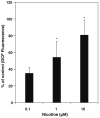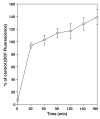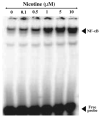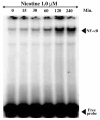Nicotine induces oxidative stress and activates nuclear transcription factor kappa B in rat mesencephalic cells
- PMID: 17021677
- PMCID: PMC2758082
- DOI: 10.1007/s11010-006-9333-1
Nicotine induces oxidative stress and activates nuclear transcription factor kappa B in rat mesencephalic cells
Abstract
Cigarette smoke is a complex mixture of more than 4700 chemical compounds including free radicals and oxidants. Toxicity exhibited by cigarette smoke may be due to combined action of these compounds inducing many cellular processes mediated through reactive oxygen species (ROS). Major player probably nicotine as it is present in tobacco, in higher concentrations. The compounds that induce intracellular oxidative stress recognized as the important agents involved in the damage of biological molecules. Experiments using animal and cell culture model systems suggested that moderately higher concentrations of some forms of ROS like NO and H(2)O(2) can act as signal transducing agents. Nuclear transcription factor kappaB (NF-kappaB) an inducible transcription factor detected in neurons found to be involved in many biological processes such as inflammation, innate immunity, development, apoptosis, and antiapoptosis. Our present study demonstrates that nicotine induces ROS levels in a dose dependent manner in rat mesencephalic cells. Electro mobility shift analysis showed that nicotine activates inducible NF-kappaB by binding to consensus sequence of DNA. Nicotine added to cell culture stimulates the degradation of IkappaB-alpha subunit in 2 h. Further activation of c-Jun terminal kinase indicates that nicotine induces oxidative stress leading to activation of stress dependent NF-kappaB pathway in mesencephalic cells.
Figures






Similar articles
-
Nicotine stimulates urokinase-type plasminogen activator receptor expression and cell invasiveness through mitogen-activated protein kinase and reactive oxygen species signaling in ECV304 endothelial cells.Toxicol Appl Pharmacol. 2012 Mar 1;259(2):248-56. doi: 10.1016/j.taap.2012.01.002. Epub 2012 Jan 9. Toxicol Appl Pharmacol. 2012. PMID: 22261521
-
Low levels of arsenite activates nuclear factor-kappaB and activator protein-1 in immortalized mesencephalic cells.J Biochem Mol Toxicol. 2005;19(2):67-77. doi: 10.1002/jbt.20062. J Biochem Mol Toxicol. 2005. PMID: 15849723 Free PMC article.
-
ERK1/2 and p38-MAPK signalling pathways, through MSK1, are involved in NF-kappaB transactivation during oxidative stress in skeletal myoblasts.Cell Signal. 2006 Dec;18(12):2238-51. doi: 10.1016/j.cellsig.2006.05.004. Epub 2006 Jun 30. Cell Signal. 2006. PMID: 16806820
-
Bidirectional regulation of NF-κB by reactive oxygen species: a role of unfolded protein response.Free Radic Biol Med. 2013 Dec;65:162-174. doi: 10.1016/j.freeradbiomed.2013.06.020. Epub 2013 Jun 19. Free Radic Biol Med. 2013. PMID: 23792277 Review.
-
The effect of reactive oxygen species on the synthesis of prostanoids from arachidonic acid.J Physiol Pharmacol. 2013 Aug;64(4):409-21. J Physiol Pharmacol. 2013. PMID: 24101387 Review.
Cited by
-
Salivary lipid peroxidation and total sialic acid levels in smokers and smokeless tobacco users as Maraş powder.Mediators Inflamm. 2012;2012:619293. doi: 10.1155/2012/619293. Epub 2012 Apr 23. Mediators Inflamm. 2012. PMID: 22577253 Free PMC article.
-
The in vitro ToxTracker and Aneugen Clastogen Evaluation extension assay as a tool in the assessment of relative genotoxic potential of e-liquids and their aerosols.Mutagenesis. 2021 May 31;36(2):129-142. doi: 10.1093/mutage/geaa033. Mutagenesis. 2021. PMID: 33769537 Free PMC article.
-
Intranasal mesenchymal stem cell secretome administration markedly inhibits alcohol and nicotine self-administration and blocks relapse-intake: mechanism and translational options.Stem Cell Res Ther. 2019 Jul 8;10(1):205. doi: 10.1186/s13287-019-1304-z. Stem Cell Res Ther. 2019. PMID: 31286996 Free PMC article.
-
Antiinflammatory and neuroprotective actions of COX2 inhibitors in the injured brain.Brain Behav Immun. 2008 Mar;22(3):285-98. doi: 10.1016/j.bbi.2007.09.011. Epub 2007 Nov 8. Brain Behav Immun. 2008. PMID: 17996418 Free PMC article. Review.
-
Nicotinic receptors in airway disease.Am J Physiol Lung Cell Mol Physiol. 2024 Feb 1;326(2):L149-L163. doi: 10.1152/ajplung.00268.2023. Epub 2023 Dec 12. Am J Physiol Lung Cell Mol Physiol. 2024. PMID: 38084408 Free PMC article. Review.
References
-
- Pailer M. Chemistry of nicotine and related alkaloids (including biosynthetic aspects) In: EulerVon US, editor. Tobacco Alkaloids and Related Compounds. The McMillan Co; New york: 1964. pp. 15–36.
-
- Hammond D, Collishaw NE, Callard C. Secret science: tobacco industry research on smoking behaviour and cigarette toxicity. Lancet. 2006;367:781–787. - PubMed
-
- Maneckjee R, Minna JD. Opioids induce while nicotine suppresses apoptosis in human lung cancer cells. Cell growth Diff. 1994;5:1033–1040. - PubMed
-
- Mandelzys A, Cooper E. Effects of ganglionic satellite cells and NGF on the expression of nicotine acetylcholine currents by rat sensory neurons. J Neurophysiol. 1992;67:1213–1221. - PubMed
-
- Heeschen C, Jang JJ, Weis M, Pathak A, Kaji S, Hu RS, Tsao PS, Johnson FL, Cooke JP. Nicotine stimulates angiogenesis and promotes tumor growth and atherosclerosis. Nat Med. 2001;7:833–839. - PubMed
Publication types
MeSH terms
Substances
Grants and funding
LinkOut - more resources
Full Text Sources
Miscellaneous

